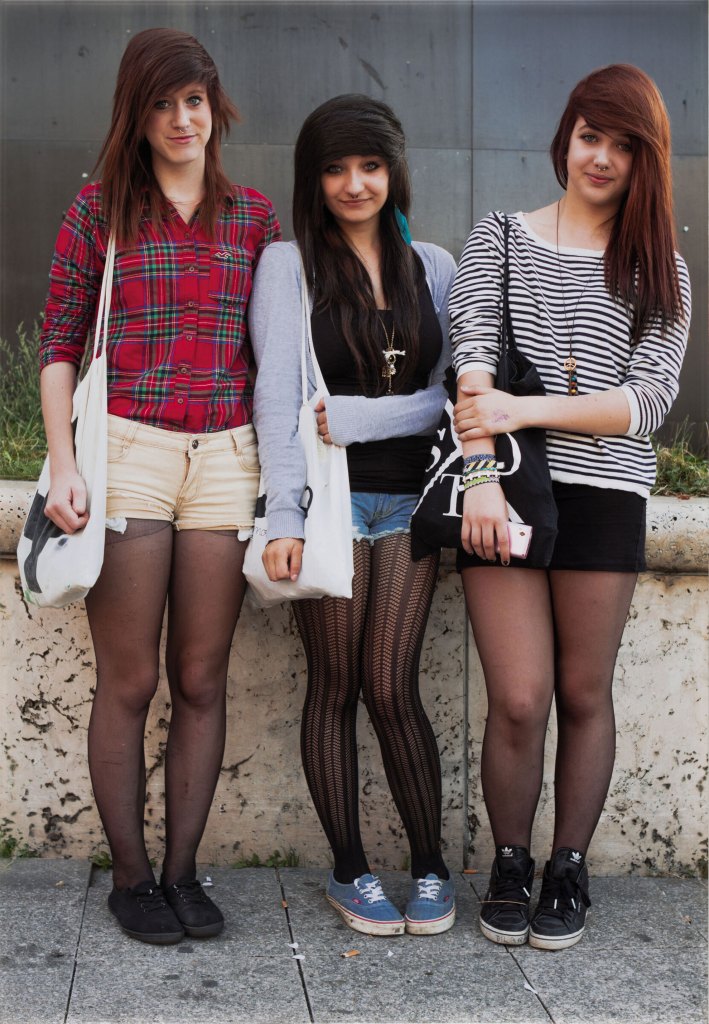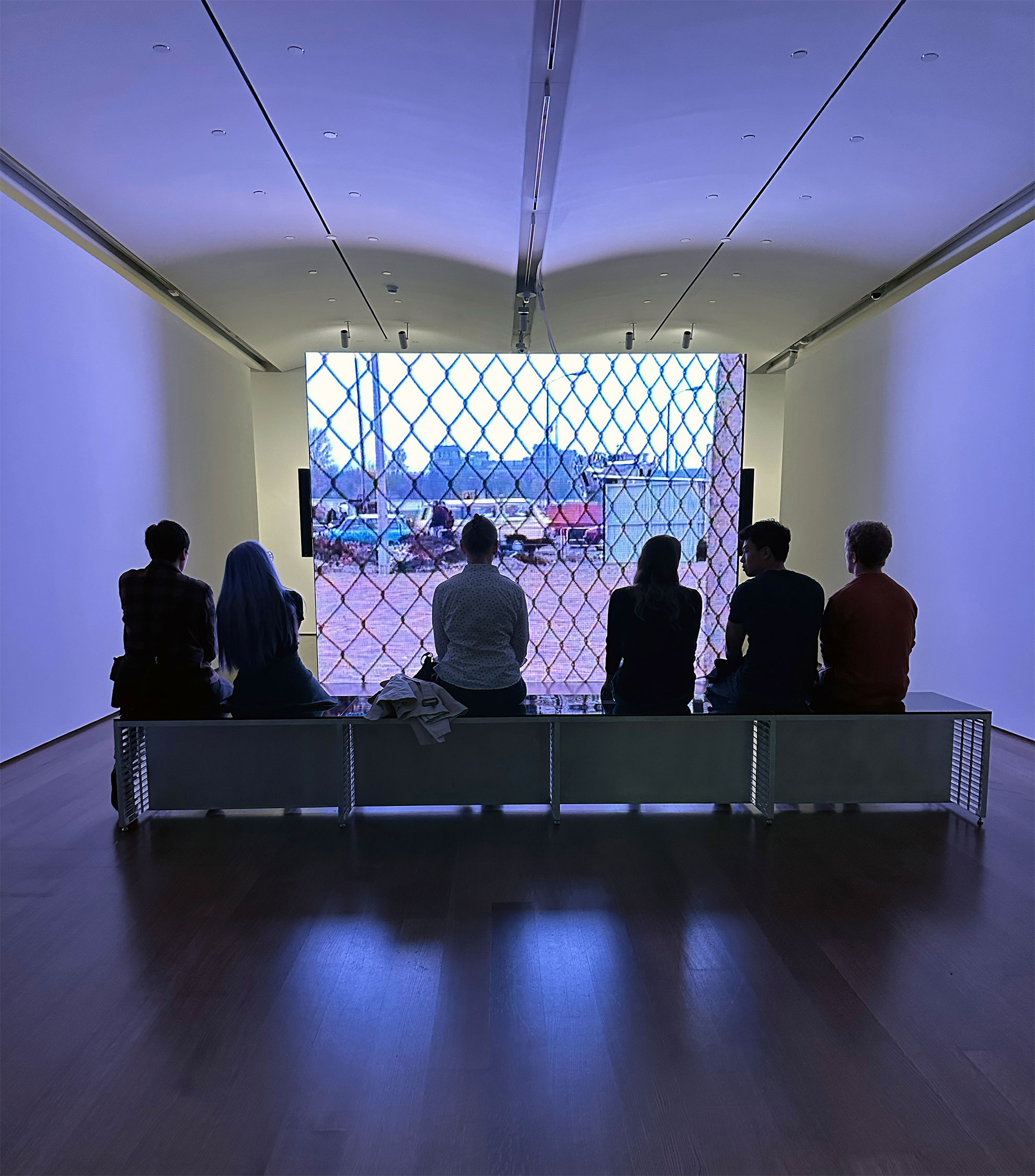Berlin-based filmmaker Hito Steyerl was 23 when she witnessed the fall of the Berlin Wall in the late 1980s and early ’90s. Some of her earliest films document this fraught period of Germany’s history, capturing the rise in xenophobic, racist, and anti-Semitic violence that followed unification. But that was more than 30 years ago, making the specifics a bit difficult to remember, she joked during an event held at the Harvard Art Museums on Oct. 29.
“It almost feels as if … a different person made these films,” she told those gathered. “It’s strange for me to try to talk about it; don’t ask me any details,” she added with a laugh.
Three films by Steyerl — “Deutschland und das Ich” (“Germany and Identity”), “Die leere Mitte” (“The Empty Centre”), and “Normalität 1-X” (“Normality 1-X”) — were recently acquired by the Busch-Reisinger Museum, the sole museum to own the works. These films are featured prominently in a current exhibition titled “Made in Germany? Art and Identity in a Global Nation.”

Nevin Aladağ’s “Best Friends Dortmund #4,” 2012.
Harvard Art Museums/Busch-Reisinger Museum, Antonia Paepcke DuBrul Fund, 2023.461. © Nevin Aladağ. Photo © President and Fellows of Harvard College; courtesy of the Harvard Art Museums

Henrike Naumann’s “Ostalgie” (2019), a room-sized installation addressing the immediate post-Wall period in Germany’s “new” federal states.
Courtesy of Henrike Naumann. Photo © President and Fellows of Harvard College; courtesy of the Harvard Art Museums
“As an exhibition, [it] features artists from different backgrounds and generations and [has work] that complicates notions of German identity, especially the idea of ethnic and cultural homogeneity,” said Lynette Roth, the Daimler Curator of the Busch-Reisinger. “We’ve seen that in recent months incredible conversations and questions around the question of national identity, both here in the United States and abroad.”
Steyerl was invited to speak as part of the annual Busch-Reisinger Museum Lecture series, which started in 2005 and is supported by the German Friends of the Busch-Reisinger Museum. She shared her experience filming her early documentaries, and explained the connection between some of her modern work and Germany’s evolution as a country, historically and technologically.
Steyerl said that one of the films, “The Empty Center” (1998), took eight years to complete. At the time, she was working with Wim Wenders, a filmmaker she met while studying in Tokyo. He was shooting a film called “Until the End of the World” and was “too busy” to capture the fall of the Berlin Wall himself, so he gave Steyerl a camera and told her to go document what she saw. Over the course of eight years, she filmed the wall coming down in an area she called “no man’s land” — what used to be a minefield between the East and the West between the two walls — and its subsequent transition and real estate development. In many ways, she hoped to highlight the transition from going to one border system (a literal wall) to another (the borders of privatization and capitalism).
“That’s basically the organizing principle of that film,” she said. “The superimpositions [are] showing something which had remained the same … but everything else had changed a lot.”
Throughout her lecture, Steyerl showed clips of her older documentaries. She also shared portions of her more contemporary work, such as her 2015 film “Factory of the Sun,” which uses different forms of imagery — video games, drone surveillance, dance — to explore financial power, control, and the spread of information in our increasingly technology-driven world.
After the event, attendees were invited to explore the “Made in Germany?” exhibit, which includes three of Steyerl’s films. Other works on display include Katharina Sieverding’s monumental pigment-on-metal print “Deutschland wird deutscher XLI/92” (“Germany Becomes More German XLI/92”) from 1992; Ulrich Wüst’s hand-crafted leporello (accordion book) “Hausbuch” (“House Book”) (1989–2010); and a loan of East Germany-born Henrike Naumann’s “Ostalgie” (2019), a room-sized installation addressing the immediate post-Wall period in Germany’s “new” federal states. Additionally, a special “Made in Germany?” playlist featuring music from the 1980s to today is available on Spotify, as well as a print catalog accompanying the exhibit.
The exhibition is on view through Jan. 5, 2025, in the Special Exhibitions Gallery and adjacent University Research Gallery on Level 3 of the Harvard Art Museums.
Source link

